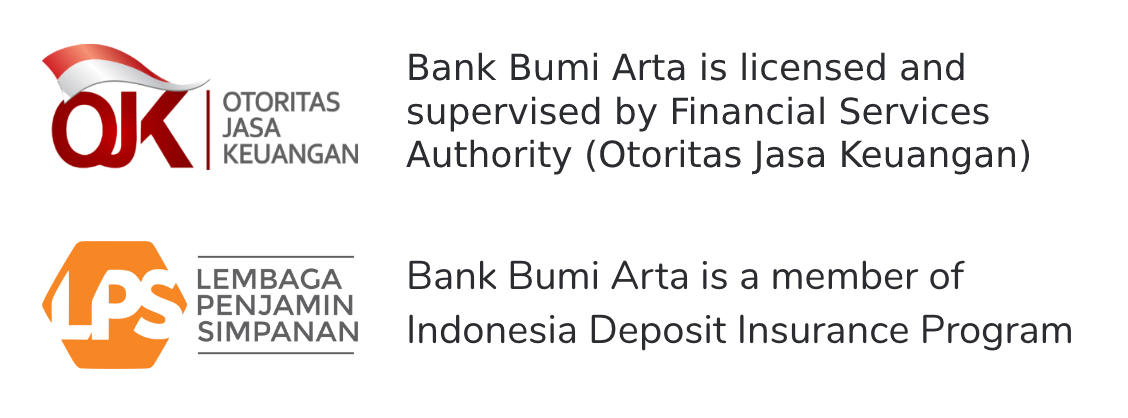
Network

SBDK

Exchange Rate

Simulation
About BBA
Home /
/
Dividend Policy
I. INTRODUCTION
A. Background
Due to the demands for banks to operate by implementing reliable and integrated governance, risk management, and compliance, the Bank must apply Good Corporate Governance principles, particularly related to the rights of shareholders and equal treatment for all Bank shareholders. Therefore, the Bank needs to establish provisions governing dividends.
B. Purpose
1. To ensure all Shareholders receive their rights and are treated equally regarding dividends distributed by P.T. Bank Bumi Arta Tbk. (“Bank”).
2. To ensure the Bank distributes dividends in accordance with Good Corporate Governance and applicable regulations while safeguarding the Bank’s interests.
C. Legal Basis
1. Law No. 40 of 2007 dated August 16, 2007 concerning Limited Liability Companies.
2. Law No. 7 of 1983 dated December 31, 1983 concerning Income Tax.
3. Law Number 36 of 2008 dated September 23, 2008 concerning the Fourth Amendment to Law Number 7 of 1983 concerning Income Tax.
4. Government Regulation Number 9 of 2021 dated February 2, 2021 concerning Tax Treatment to Support Ease of Doing Business.
5. Government Regulation Number 55 of 2022 dated December 20, 2022 concerning Adjustment of Regulations in the Field of Income Tax.
6. Minister of Finance Regulation Number 111/PMK.03/2010 of 2010 dated June 14, 2010 concerning Procedures for Withholding, Depositing, and Reporting Income Tax on Dividends Received or Earned by Individual Domestic Taxpayers.
7. Financial Services Authority Regulation Number 15/POJK.04/2020 dated April 20, 2020 concerning the Planning and Implementation of the General Meeting of Shareholders of Public Companies.
8. Financial Services Authority Regulation Number 17 of 2023 dated September 14, 2023 concerning the Implementation of Governance for Commercial Banks.
D. General Definitions
1. Commercial Bank (Bank): A bank operating conventionally, providing services in payment traffic.
2. Board of Commissioners: Bank organ supervising in general and/or specifically according to the articles of association and advising the Board of Directors.
3. Board of Directors: Bank organ with full authority and responsibility for managing the Bank and representing it, internally and externally, based on the articles of association.
4. Dividend: Portion of profit received or earned by shareholders.
5. Limited Liability Company (Company/Bank): A legal entity in the form of a capital alliance established by agreement and divided into shares.
6. Stakeholders: All parties directly or indirectly interested in the Bank’s business.
7. General Meeting of Shareholders (GMS): Bank organ holding powers not assigned to the Board of Directors or Commissioners.
8. Good Corporate Governance: Structures, processes, and mechanisms for managing the Bank in a way that considers stakeholder interests, enhances value sustainably, and complies with laws, ethical values, and applicable principles.
E. General Provisions
1. The Bank must allocate a portion of its net profit annually as reserves, mandatory when positive retained earnings exist.
2. This allocation continues until the reserve reaches at least 20% of issued and paid-up capital. If not yet achieved, reserves may only cover losses not met by other reserves.
3. Net profit usage, including reserve allocation, is decided by the GMS.
4. Dividend plans prioritize the Bank’s interest and are stated in the Bank's Business Plan. Dividends distributed are in the form of cash dividends.
5. Dividend policy must be communicated to shareholders through the Bank's website.
6. Dividend calculation must be based on reasonably generated profitability, excluding extraordinary income.
F. Bank Considerations in Dividend Distribution
1. Internal factors:
a. Financial performance realization
b. Business growth plans
c. Future profitability outlook
d. Bank health level
e. Capital adequacy fulfillment
f. Internal risk potential
g. Future capital strengthening needs
2. External factors:
a. Economic conditions and outlook
b. External risk potential
c. Compliance with laws, including taxation
d. Guidance from supervisory authorities
e. Shareholder input and aspirations
G. Dividend Amount
1. All net profit, post-reserve, is distributed as dividends per GMS decision.
2. Dividends may only be distributed if positive retained earnings exist.
3. Distribution must support healthy operations and sustain the Bank’s performance and shareholder ROI.
4. Calculations must reflect reasonable Bank profitability.
5. Proposals and implementation must comply with laws and Bank articles of association.
H. Dividend Distribution Approval Mechanism
1. Plans are based on shareholders’ rights, considering internal and external factors.
2. Board of Directors discusses and proposes profit usage for dividends.
3. The proposal is submitted to the Board of Commissioners, then to the GMS for shareholder approval.
I. Tax Deduction, Payment, and Reporting Mechanism
1. Dividends are subject to applicable taxes.
2. Final income tax on dividends is withheld by the paying party or appointee.
3. Withholding is done upon dividend payment.
4. The Bank must issue a tax deduction certificate to individual resident taxpayers.
5. The Bank must deposit the tax to the State Treasury no later than the 10th of the month after the tax period ends.
6. Payments are made via a Tax Payment Slip. If the deadline falls on a holiday, payment is deferred to the next working day.
7. The Bank must report deductions and deposits within 20 days after the tax period ends, extendable to the next working day if on a holiday.
8. Reporting is done using a Final Income Tax Return Form.
J. Dividend Payment Period
1. The Bank must pay dividends no later than 30 days after the summary of the GMS decision is announced.
2. The Bank must report to the Exchange and announce the GMS summary within 2 trading days post-GMS.
3. The record date is used to determine shareholder rights for dividend receipt.
K. Dividend Policy Review Period
The Dividend Policy is updated periodically in line with regulatory changes.
 USD
USD  EUR
EUR  JPY
JPY  AUD
AUD  HKD
HKD  SGD
SGD  CNY
CNY 






 ATM
ATM

